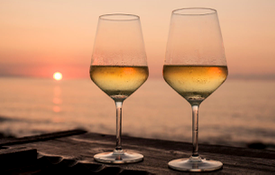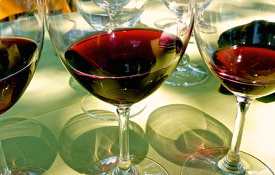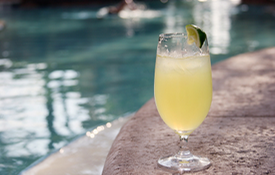
Keep Summer Alive
Somehow the calendar got set to fast-forward and now Labor Day weekend is soon upon us. It is widely believed that Labor Day is the unofficial end of summer but I’m not having any of that. Before the winter scarfs are taken from storage and the snow blower is tuned for winter I have more summer living to do.
It’s time for new traditions and I propose the following addition to the Labor Day weekend. At the stroke of happy hour place your cocktail, beer, or glass of wine on top of your grill (hopefully it’s not hot). If you see the drinks shadow this will indicate six more weeks of summer.
Of course, summer can be a state of mind, as well as a position on the calendar. By eating summer foods and drinking summer drinks we can keep the spirit of summer alive. To aid in your conquest to keep summer alive I have assembled a few drink ideas that will absolutely keep summer rolling at your home.
Wines that Keep Summer Alive (all can be found for less than $20 a bottle)
Albarino is a white variety best known for its resulting crisp and fruity wines produced in NW Spain. These wines enjoyed a burst of popularity early this century, especially in Spanish Tapas restaurants. However, they can be just as enjoyable at home as they are extremely versatile and elegant with nothing but a glass. Buy them as fresh as possible (2014 or 2015 vintage).
Falanghina is an ancient white variety, the Romans originally brought this variety from Greece, grown primarily in Italy’s Campania region. The wines are quite unique being fruity and exotic while crisp with bright acidity. It’s impossible to compare the flavors of this unique varietal to any popular style or grape.
Vouvray is a longtime favorite as it delivers pure hedonistic pleasure. The wine hails from France’s Loire Valley and it’s made entirely with Chenin Blanc. Chenin Blanc can produce tasty wines in most wine making countries but there is something magical about Vouvray as it perfectly captures the grape’s fruity and acidic sides. Vouvray comes in a variety of styles from dry to very sweet desert wines and even a beautiful sparkling version.
Soave is a bright and deceivingly complex white based on the ancient Garganega grape that is grown nearly exclusively in Veneto (Northeastern Italy). Soave, like a handful of Italian wines, got a bad rap years ago as the export markets were flooded with cheap, uninspiring versions. Today Soave is enjoying a renaissance and a new audience. The wines are bright with unique fruit flavors and a perfect balance of acidity. You may never go back to your Pinot Grigio after drinking Soave.
Cava is Spain’s sparkling wine. Like Champagne, it’s made in the laborious Traditional Method that employs a natural secondary fermentation in the bottle. Despite the similarity of process Cava is much less expensive than Champagne and much more in line with Prosecco prices while Prosecco is made in a bulk method that adds bubbles to an entire tank of wine prior to bottling. Cava can be made in eight of Spain’s wine regions while well over 90% is made in the Catalonian DO of Penedès.
How about some Reds…

Red Wines in Summer
Valpolicella is one of Italy’s best-known wine districts. It is located primarily in the hills just north of Verona in Italy’s Northeastern region of Veneto. There are many different variations of Valpolicella beyond the typical dry red wine that most people know. Valpolicella can be sweet, sparkling or a unique, rich red called Amarone that is made from grapes that have been allowed to partially dry after harvest. Amarone is quite expensive but luckily there is a Valpolicella version known as Ripasso. Ripasso della Valpolicella is made by adding the leftover Amarone pomace (grape solids) to vats of Valpolicella. This process adds additional body and richness to the wine and many people refer to Ripasso as a baby Amarone (at a fraction of the price).
No summer is complete without enjoying glass after glass of Côtes du Rhône Rouge. This frequently Grenache forward wine comes form the Rhône Valley and it is one of the most versatile wines at the table pairing with a wide range of dishes. When in doubt, reach for a bottle of Côtes du Rhône Rouge. The supple fruit flavors with hints of herbs and earth are delivered with little tannin and enough bright acidity to keep it ultra balanced. A bonus is that you can find a wide variety of labels being sold for less than $20 a bottle and often for under $15.
Of course, drink up those Rosé wines!
Beers that Keep Summer Alive
Nothing says summer like Witbier and Weizen. The big frothy head and the cloudy beer is a summer staple. Witbier is cloudy, deep gold to copper in color with a thick, rocky white head. It is very refreshing and an ideal summer session Beer being enjoyed by most everyone from the aficionado to the novice. Learn more about Wit & Weizen HERE.
Kölsch is a style of beer just waiting to be discovered by the masses (the Germans have known this for some time). It has the appearance and drinkability of a lager, the aromatics of an ale, and the refreshing qualities of Prosecco. In short, it’s hard to have just one Kölsch. This style is wonderfully fresh and crisp with just enough of a malt note to add depth and interest. A well-made Kölsch is a tremendous session beer. Learn more about Kölsch HERE.

Beer Cocktails Keep Summer Alive
How about the best of both worlds – Beer and Cocktails? In recent years the Shandy and its lost German twin the Radler, have become extremely popular in the US. Today it’s commonplace to find commercial bottlings of shandies from American craft and regional producers, as well as imports from Germany and Austria. While beers are becoming increasingly more potent, a 50/50 mix of beer and soft drink is a welcome choice in the hot summer months when hydration is key. Get our full Shandy story and recipe HERE.
Speaking of cocktails, don’t forget to make a big pitcher of Sangria and invite some friends and neighbors to help you drink it. Get our Sangria recipe HERE.
We hope that these few suggestions help you help us in our campaign to keep summer alive!
